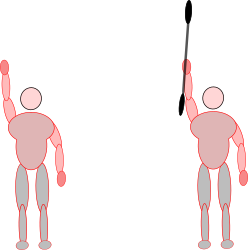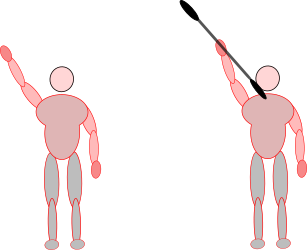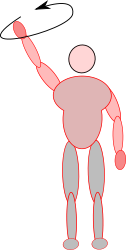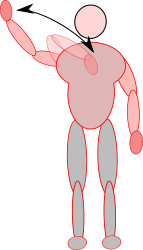Which are most important river signals to know? Here you can find a detailed list of the most important river signal internationally known. A short guide to help the communication in the noisy river environment.
One of the most important rule about river signals is: simplicity, clearness and only the necessary information.
It's important to remember to have a short briefing with your group before any river descent in order to avoid dangerous misunderstanding. Some kayaker might not follows this standard!
The standard presented below is internationally known and comes from the Rescue and Rafting world.

OK, I UNDERSTOOD
The OK signal means "OK, I UNDERSTOOD". It's important to do this signal every time you receive a communication from anyone and you have understood the message. In case you don't do this message, it means the communication has not arrived.
This signal can also be used to say "I'M ALL RIGHT" and you haven't hurt yourself or someone else is safe.

STOP signal
The STOP signal meas "STOP NOW AS FAST AS POSSIBLE. WAIT FOR NEW SIGNALS".
You can to this signal either with the arms or with the paddle. You can use this signal to stop the group or to ask to wait a bit more.
ATTENTION
This signal is very clear and visible from high distance. A simple vertical hand that move forward and back like an "ALT" signal, can generally be confused with a "GO" and thus it's not a river signal.

GO AHEAD signal
The GO AHEAD signal means: "GO STRAIGHT IN THE MIDDLE, NOTHING TO SCOUT".
You can to this signal either with the arms or with the paddle. It's important to give this signal only if the rapid or the drop can be done without any other additional information or scouting. It can also be used to ask the group to proceed ahead.

GO LEFT signal
The GO LEFT signal means: "GO LEFT, NOTHING TO SCOUT".
You can to this signal either with the arms or with the paddle. It's important to give this signal only if the rapid or the drop can be done without any other additional information or scouting.
Of course the opposite "GO RIGHT" signal can be done pointing the arm or the paddle in the opposite direction. If you wish to be more precise and have different signals for "GO HARD LEFT" and "GO MIDDLE-LEFT" you need to specify your standard before the run with your group. A misunderstanding in the river can lead to dangerous situations.

STOP IN THE EDDIE signal
The signal "STOP IN THE EDDIE" means: "STOP IN THE FIRST EDDIE ON RIVER LEFT".
You can to this signal either with the arms or with the paddle. It's possible to point the eddie you want with your finger after this signal. In this way you can ask to another kayaker to stop in a specific place. In general terms, it communicate to the group you want everybody to stop on river left.
Of course the opposite "STOP IN THE EDDIE ON RIVER RIGHT" signal can be done pointing the arm or the paddle in the opposite direction.

COME HERE signal
The COME HERE signal means: "COME TO ME, MEETING HERE".
You ask the group to meet up where you are. You can use it if you need to do a briefing or you have some safety issue to solve all together .

SAFETY REQUIRED signal
The SAFETY signal means: "SET UP SAFETY". You ask the group to cover a drop or a rapid using through bags or other safety measures.

UNRUNNIBLE signal
The UNRUNNIBLE signal meas: "THE NEXT DROP OR RAPID IS UNRUNNIBLE". You can also point with your finger the place or drop you want to define unrunnible.
It's important to not define a drop unrunnible only if you think to portage it. Other kayakers might want to scout it before to portage it. Use this signal only if the drop is obstructed and 100% unrunnible.

SCOUT signal
The SCOUT signal means: "YOU NEED TO SCOUT THE DROP".
This signal means that you must scout the drop before running it or portage. It's important to request a scout all the time a drop can't be run only with the indication of the starting point: left, middle or right.

PORTAGE signal
The PORTAGE signal means: "START THE PORTAGE" or "I'M PORTAGING".
This signal require to begin the portage directly without scouting. It can also be used in order to communicate you are going to portage one drop or rapid.

I CAN'T SEE signal
This signal means: "I CAN'T SEE".
You can use this signal to notify you can't see or scout the drop from my position. You can also use this signal in order to communicate you can't see a missing person or kayak.

EMERGENCY signal
This signal means: "SOMEONE IS INJURED AND I NEED FIRST AID".
If you see this signal you might take your first aid kid or be ready to call the emergency service.


